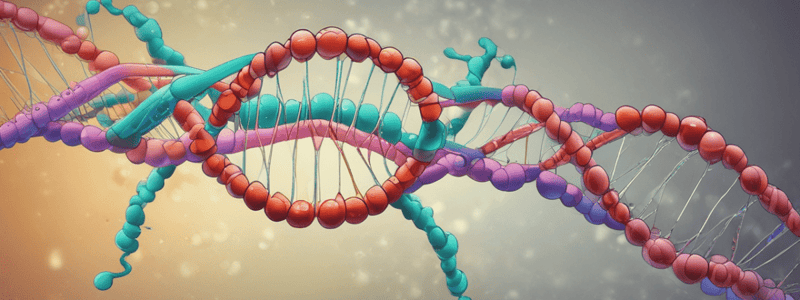Podcast
Questions and Answers
What is the sugar molecule found in RNA?
What is the sugar molecule found in RNA?
- Glucose
- Deoxyribose
- Fructose
- Ribose (correct)
Which type of RNA is involved in protein synthesis by carrying genetic information from DNA to the ribosome?
Which type of RNA is involved in protein synthesis by carrying genetic information from DNA to the ribosome?
- mRNA (correct)
- miRNA
- rRNA
- tRNA
What is the function of miRNA and siRNA?
What is the function of miRNA and siRNA?
- Catalysis
- RNA processing
- Protein synthesis
- Gene regulation (correct)
What is the process of creating RNA from DNA?
What is the process of creating RNA from DNA?
What is the role of RNA polymerase in RNA synthesis?
What is the role of RNA polymerase in RNA synthesis?
What is unique about the phosphate group in RNA?
What is unique about the phosphate group in RNA?
Flashcards are hidden until you start studying
Study Notes
Structure of RNA
- Single-stranded molecule
- Composed of nucleotides (A, C, G, and U)
- Sugar molecule: ribose
- Phosphate group: RNA has a hydroxyl (-OH) group on the 2' carbon of the ribose sugar
Types of RNA
- mRNA (Messenger RNA): carries genetic information from DNA to the ribosome for protein synthesis
- tRNA (Transfer RNA): brings amino acids to the ribosome during protein synthesis
- rRNA (Ribosomal RNA): makes up a large part of the ribosome, which translates mRNA into protein
- miRNA (MicroRNA): regulates gene expression by binding to mRNA
- siRNA (Small Interfering RNA): also regulates gene expression by degrading mRNA
- snRNA (Small Nuclear RNA): involved in various aspects of RNA processing
- snoRNA (Small Nucleolar RNA): guides chemical modifications of rRNA
Functions of RNA
- Protein synthesis: mRNA provides the template for protein synthesis
- Gene regulation: miRNA and siRNA regulate gene expression
- RNA processing: snRNA and snoRNA are involved in splicing, capping, and polyadenylation of RNA
- Catalysis: some RNA molecules (ribozymes) can catalyze chemical reactions
RNA Synthesis
- Transcription: the process of creating RNA from DNA
- Initiation: RNA polymerase binds to the DNA template
- Elongation: RNA polymerase adds nucleotides to the growing RNA chain
- Termination: RNA polymerase releases the RNA transcript
Structure of RNA
- RNA is a single-stranded molecule composed of nucleotides (A, C, G, and U)
- The sugar molecule in RNA is ribose, which has a hydroxyl (-OH) group on the 2' carbon
Types of RNA
- mRNA carries genetic information from DNA to the ribosome for protein synthesis
- tRNA brings amino acids to the ribosome during protein synthesis
- rRNA makes up a large part of the ribosome, which translates mRNA into protein
- miRNA regulates gene expression by binding to mRNA
- siRNA regulates gene expression by degrading mRNA
- snRNA is involved in various aspects of RNA processing, such as splicing, capping, and polyadenylation
- snoRNA guides chemical modifications of rRNA
Functions of RNA
- mRNA provides the template for protein synthesis
- miRNA and siRNA regulate gene expression by binding to and degrading mRNA, respectively
- RNA processing involves the splicing, capping, and polyadenylation of RNA, facilitated by snRNA and snoRNA
- Some RNA molecules, known as ribozymes, can catalyze chemical reactions
RNA Synthesis
- Transcription is the process of creating RNA from DNA
- RNA polymerase initiates transcription by binding to the DNA template
- During elongation, RNA polymerase adds nucleotides to the growing RNA chain
- Transcription terminates when RNA polymerase releases the RNA transcript
Studying That Suits You
Use AI to generate personalized quizzes and flashcards to suit your learning preferences.




